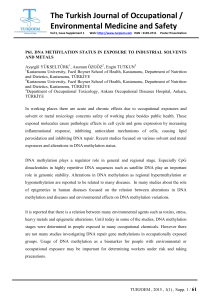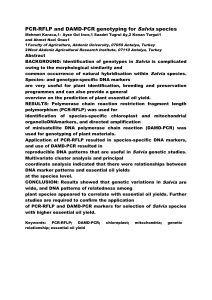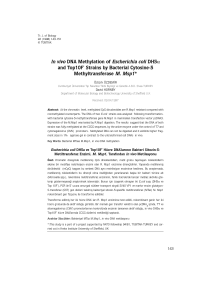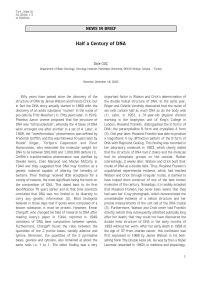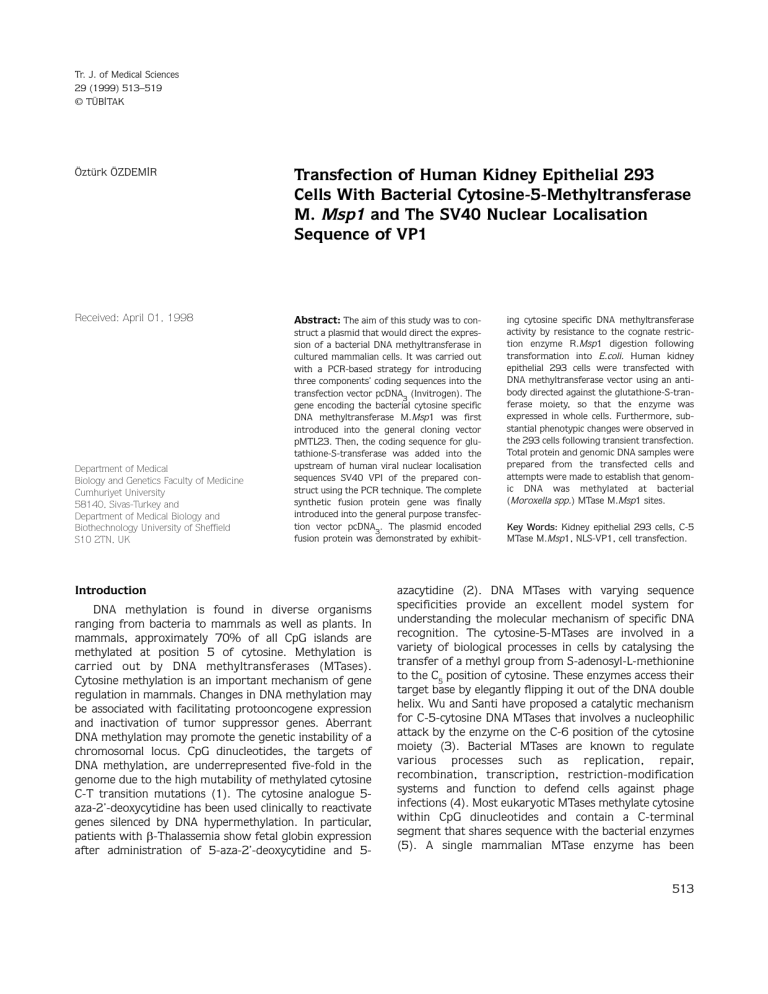
Tr. J. of Medical Sciences
29 (1999) 513–519
© TÜBİTAK
Öztürk ÖZDEMİR
Transfection of Human Kidney Epithelial 293
Cells With Bacterial Cytosine-5-Methyltransferase
M. Msp1 and The SV40 Nuclear Localisation
Sequence of VP1
Received: April 01, 1998
Abstract: The aim of this study was to construct a plasmid that would direct the expression of a bacterial DNA methyltransferase in
cultured mammalian cells. It was carried out
with a PCR-based strategy for introducing
three components’ coding sequences into the
transfection vector pcDNA (Invitrogen). The
3
gene encoding the bacterial cytosine specific
DNA methyltransferase M.Msp1 was first
introduced into the general cloning vector
pMTL23. Then, the coding sequence for glutathione-S-transferase was added into the
upstream of human viral nuclear localisation
sequences SV40 VPI of the prepared construct using the PCR technique. The complete
synthetic fusion protein gene was finally
introduced into the general purpose transfection vector pcDNA3. The plasmid encoded
fusion protein was demonstrated by exhibit-
Department of Medical
Biology and Genetics Faculty of Medicine
Cumhuriyet University
58140, Sivas-Turkey and
Department of Medical Biology and
Biothechnology University of Sheffield
S10 2TN, UK
Introduction
DNA methylation is found in diverse organisms
ranging from bacteria to mammals as well as plants. In
mammals, approximately 70% of all CpG islands are
methylated at position 5 of cytosine. Methylation is
carried out by DNA methyltransferases (MTases).
Cytosine methylation is an important mechanism of gene
regulation in mammals. Changes in DNA methylation may
be associated with facilitating protooncogene expression
and inactivation of tumor suppressor genes. Aberrant
DNA methylation may promote the genetic instability of a
chromosomal locus. CpG dinucleotides, the targets of
DNA methylation, are underrepresented five-fold in the
genome due to the high mutability of methylated cytosine
C-T transition mutations (1). The cytosine analogue 5aza-2’-deoxycytidine has been used clinically to reactivate
genes silenced by DNA hypermethylation. In particular,
patients with β-Thalassemia show fetal globin expression
after administration of 5-aza-2’-deoxycytidine and 5-
ing cytosine specific DNA methyltransferase
activity by resistance to the cognate restriction enzyme R.Msp1 digestion following
transformation into E.coli. Human kidney
epithelial 293 cells were transfected with
DNA methyltransferase vector using an antibody directed against the glutathione-S-tranferase moiety, so that the enzyme was
expressed in whole cells. Furthermore, substantial phenotypic changes were observed in
the 293 cells following transient transfection.
Total protein and genomic DNA samples were
prepared from the transfected cells and
attempts were made to establish that genomic DNA was methylated at bacterial
(Moroxella spp.) MTase M.Msp1 sites.
Key Words: Kidney epithelial 293 cells, C-5
MTase M.Msp1, NLS-VP1, cell transfection.
azacytidine (2). DNA MTases with varying sequence
specificities provide an excellent model system for
understanding the molecular mechanism of specific DNA
recognition. The cytosine-5-MTases are involved in a
variety of biological processes in cells by catalysing the
transfer of a methyl group from S-adenosyl-L-methionine
to the C5 position of cytosine. These enzymes access their
target base by elegantly flipping it out of the DNA double
helix. Wu and Santi have proposed a catalytic mechanism
for C-5-cytosine DNA MTases that involves a nucleophilic
attack by the enzyme on the C-6 position of the cytosine
moiety (3). Bacterial MTases are known to regulate
various processes such as replication, repair,
recombination, transcription, restriction-modification
systems and function to defend cells against phage
infections (4). Most eukaryotic MTases methylate cytosine
within CpG dinucleotides and contain a C-terminal
segment that shares sequence with the bacterial enzymes
(5). A single mammalian MTase enzyme has been
513
Transfection of Human Kidney Epithelial 293 Cells With Bacterial Cytosine-5-Methyltransferase M. Msp1 and
The SV40 Nuclear Localisation Sequence of VP1
characterised and cloned (6). This enzyme displays
methylation of hemimethylated CpG and de novo
methylation of hemimethylated CpG dinucleotides (7, 8).
O6-methylguanine and 04-methylthymine are potentially
mutagenic DNA lesions that cause G:C→Α:Τ or Α:Τ→G:C
transition mutations by mispairing during DNA
replication. The repair of these mutations by DNA repair
methyltransferases is therefore expected to prevent
methylation-induced transitions (9). Specific genes can be
stable or transiently introduced into cultured cells by
vector-mediated gene transfer. Basically, there are two
types of experiments using mammalian cell gene transfer
techniques. One of these is transient transfection, which
allows gene products, either RNA or protein, to be
obtained within hours of DNA uptake. The other is stable
transfection, which allows plasmid vector DNA integrated
into the host cell chromatin to be obtained up to 24-80h
following uptake of DNA. In this manner, we constructed
a new PCR gene fusion product (NLS+GST+MTase
M.Msp1 genes) and introduced it into vector pcDNA3. The
newly constructed plasmid was named pOZT 4 (10). In
this study, the human epithelial 293 cells were
transfected and co-transfected with newly constructed
plasmid and pAdVantage (Invitrogen) using the CaPO4 coprecipitation method (11). Using a bacterial fusion gene,
the aim was to transfer it into the mammalian cell and
determine its methylase activity on mammalian genomic
DNA by table gene transfection.
Materials and Methods
PCR and Oligonucleotides
In order to establish an expression vector, we
constructed a genetic fusion of a bacterial cytosine-5
specific DNA MTase with a vertebrate nuclear targeting
sequence and marker enzyme glutathione-S-transferase
genes. Amplification of the bacterial M.Msp1 gene was
carried out using 100ng template DNA with forward and
reverse primers (10). The PCR was set up according to
the protocol outlined in the expand long template PCR
system package insert. Primers were synthesised on a
model 381 A DNA synthesiser by the biomolecular
synthesis service of the Krebs Institute to create
restriction sites at both ends of HindIII-EcoRI with PCR
and thereby enable its insertion into the cloning vectors.
The PCR product was obtained after 30 cycles of the
reaction involving denaturation at 94˚C for 1.5 minutes,
annealing at 50-52˚C for 2 minutes and polymerisation at
72˚C for 3 minutes. This gene was also amplified for the
insertion of NLS+GST+M.Msp1 gene fusion into the
vector (10).
514
Cell Transfection and Tissues
All the cell lines used in this study were kindly donated
by Dr. D.P. HORNBY. The human embryonic 293 kidney
cells were maintained in a MEM medium supplemented
with 10% fetal calf serum. All cultures were grown at
37˚C in a humidified 5% CO2 95% air incubator. Cells
were seeded at 1x106 cells per 19 cm plate, and after 24
h the cultures were co-transfected using the calcium
phosphate precipitation method with 10µg of 1:10 pOZT
4 and pAdVantage. First, different concentrations of
pOZT4 (5µg-20µg) and pAdVantage (1µg-5µg) were
mixed and made up to 100µl with TE (10mM Tric.Cl
pH:8, 1mM EDTA) buffer. Then, 100µl of x10 solution I
[(18.36 g CaCl2 and 0.125 M Hepes, pH 7.15 (Gibco
BRL) /100µl sterile water)] and 300µl of solution II
(25mM Hepes, pH 7.15) were added to be DNA. After
this, 500µl o f solution III (280mM NaCl, 1.5mM
Na2HPO4, 325mM Hepes, pH 7.15) was added dropwise
to the DNA mix. Whilst solution III was being added, air
was gently bubbled through the DNA solution. The final
solution was left at room temperature for 5 minutes, and
a very fine precipitate was formed. Finnaly, this fine DNA
precipitate was added to the cell to be transfected.
Approximately 24 h after transfection, cultures were
seeded at 1x106 cells and 20x106 per 10 cm plate in a
medium containing G418 (1000µg ml-1 neomycin). This
medium with G418 was changed every 2 or 3 days until
neo-resistant colonies developed (approximately 6-7
weeks). G418-resistant cell subclones were isolated and
maintained as local populations in media containing
800µgml-1 neomycin.
Isolation of Nuclear DNA from Transfected Cells
High-molecular-weight DNA was extracted from the
cells by lysis in 1% SDS/10mM NaCl/50mM Tris-HCl,
pH:7.4/ 10mM EDTA, then treated with RNase A (100µg
ml-1 ) and proteinase K (1mg/ml). Following this, the
reactions were extracted twice with phenol and once with
chloroform and then precipitated with ice-cold ethanol
and redissolved in TE (10mM Tris.Cl, pH:8, 1mM EDTA).
Meanwhile, high-molecular-weight DNA was also
prepared for pulsed-field gel electrophoresis. In brief,
after overnight incubation of the cells in L buffer (0.1M
EDTA pH:8/0.01M Tris.Cl pH:7.6/ 0.02M NaCl), the DNA
was mixed with 1% melted agarose in L buffer again and
the mixture stirred with a selade pipette. SDS and
proteinase K were added to a final concentration of 1%
and 1mg/ml respectively and the reaction was incubated
at 37˚C overnight. Following incubation, the DNA was
extracted, precipated and electrophoresed on 2% agarose
gel.
Ö. ÖZDEMİR
SDS-PAGE and Immunobloting
Protein expresison and purification from the
transfected, co-transfected and control cells were
analysed by SDS-PAGE electrophoresis. Typically, 1012.5% SDS polyacrilamide gels were prepared for
protein separation. Protein samples were denatured by
heating at 100˚C for 5-10 minutes after the addition of
an equal volume of SDS gels loading buffer and run under
denaturing conditions on 10-12.5% polyacrylamide gels
at 100-160 volts. When the protein concentration was at
an undetectable level, staining with commasie blue,
western blotting and the ECL development technique
were used to detect the minute amount of DNA.
Western Blot and ECL Development
After the protein separation with SDS-PAGE and
retarded DNA gels, one piece of nitro-cellulose membrane
(Hybond TM-ECL) and 8 pieces of Whatman paper (3mm)
were soaked in transfer buffer (TTB: 3.03 g trismethylamine +14.4 g glycine +200 ml methanol in 1 L
MQ pH:8.3) for 15 minutes. The gels were placed on top
of 4 sheets of Whatman paper, air bubbles were removed
and placed on the nitro-cellulose membrane, and another
4 layers of Whatman paper were placed on top. This
sandwich was blotted across at a constant voltage of 9 V
for 30 minutes. Nitro-cellulose membranes were
incubated with 1x TBS (x10 TBS: 24.228 g trismethlamine+292 g NaCl into 1 L.MQ, pH7.5) for 30
minutes. The block membrane was blotted in 5% of
blotto semi-skimmed milk powder (Marvel) in TTBS
overnight at room temperature and incubated with antiGST for 90 minutes. After washing 3 times with TTBS
buffer, the nitro-cellulose membrane was incubated with
a second antibody (anti-rabbit IgG- alkaline phosphate
conjugate rose in goat, Sigma) at a dilution of 1:1000
also in TTBS buffer for 1 hour at room temperature. A
further 3 washes were carried out with TBS. The
immuno-blot was developed in an ECL reagent kit for 1
minute in 3.75 ml reagent 1 and 3.75 ml reagent 2
mixtures.
cells was digested with R.Msp1 and R.HpaII for detection
of methylase activity of bacterial MTase M.MspI on the
genomic DNA of those cells. The digestion procedures
were as follows: 5µl genomic DNA+2µl R.Msp1 or
R.HpaII buffer+2µl RNase+1µl R.Msp1 or R.HpaII+9µl
MQ water. The reaction mixture was incubated at 37˚C
for 3 hours and DNA samples were routinely run on 1%
agarose gels.
Results
In order to establish an expression vector, we
constructed a genetic fusion of a bacterial cytosinespecific DNA methyltransferase (C-5 cytosine MTase
M.Msp1) with a vertebrate nuclear targeting signal (NLSSV40 VP1) and the marker enzyme glutathion-Stransferase (GTS). The new vector was named pOZT4
and cloned, and was expressed in a few E.coli strains (10,
Restriction Enzyme Assay
Restriction digestion was assayed by incubating 1 µg
DNA in a total volume of 20 µl with 10-20 units of
restriction enzyme. Digests were carried out at the
recommended temperatures (usually 37˚C) for 2-24 h,
using specific buffers supplied with the enzymes.
Restriction cleavages were then analysed by 1% agarose
gel electrophoresis.
Assay of Methyltransferase Activity
DNA from the control, transfected and co-transfected
Figure 1.
Agarose gel electrophoresis of plasmid DNA from transformed E.coli strains with pOZT4 and digested with restriction enzyme. R.Msp1. All plasmid DNA was fully methylated.
Lanes 1 and 2: Plasmid DNA from Top10F’ strain
Lane 3:λ DNA cut with HindIII/EcoRI
Lane 4: Plasmid DNA from DHα5 strain
Lane 5: Untransformed pUC19 plasmid DNA
515
Transfection of Human Kidney Epithelial 293 Cells With Bacterial Cytosine-5-Methyltransferase M. Msp1 and
The SV40 Nuclear Localisation Sequence of VP1
Figure 3.
Figure 2.
Western-immunoblot analysis and ECL development of
NLS+GST+MTase M.Msp1 protein from transfected cell
lines with pOZT4. Proteins from indicated cell lines were
loaded onto a 10% SDS-PAGE gel and electrophoresed.
Proteins were electroblotted onto a nitro-cellulose membrane (Hybond TM-ECL), which was probed with monoclonal antibodies specific for Ab-1 anti glutathion-S-transferase (Sigma) and Ab-2 anti-rabbit horse-radish peroxidase
(Ammersham Life Science). Arrow indicates 66.45 kDs
protein.
12). The prior expression and plasmid DNA was tested by
restriction enzyme, R.Msp1 and R.HpaII digestion. It was
found that the methylated DNA from the transfected cell
could not be cut and it exhibited higher fragment sizes in
a 1% agarose gel electrophoresis in contrast to the DNA
from untransfected cells (Figure 1-lanes 1, and 4).
Transfection of mammalian cells with expression vector
often results in suboptimal expression of the protein of
interest. Co-transfection of cells with the pAdVantage
vector enhances transient protein expression in a variety
of cell types by increasing translation initiation. In this
study, human kidney epithelial 293 cells were cotransfected with pOZT4 and pAdVantage at ratios of
1:10, 1:5 and 1:1 and grown in MEM and Dulbecco’s
modified Eagle’s medium containing 10% fetal calf
516
Genomic DNA extracted from transfected and untrasfected
human kidney 293 cells and digested with R.Msp1.
Lanes 1 and 4: 2% gel electrophoresis of DNA from
untransfected cells.
Lanes 2 and 3: DNA from transfected cells
Lane 5: λ DNA cut with HindIII
Lane 6: λ DNA cut with HindIII/EcoRI
serum. Substantial phenotypic changes were observed in
the 293 cells following transient transfection. For the
detection of fusion protein activity, the genomic DNA
from 24 hour-45 day transfectants was analysed and
pulsed-field electrophoresis, western-SDS-PAGE and
DNA-protein analyses were performed. Transfected and
untransfected cells were valuated by daily cell counts of
erthrosin B dye exclusion. DNA and protein samples were
extracted from stably and transiently transfected cells and
control cells according to the standard procedure. The
DNA samples were than cleaved with the isoschizomeric
restriction endonucleases Msp1 and HpaII and
electrophoresed on 2% agarose gels. The results of this
indicated that the inserted gene had been successfully
expressed with the obvious appearance of a band on the
gels at approximately 66.45 kDs in the 293 cell samples
using the western-immunoblot analysis and ECL
development (Figure 2). Genomic restriction digests were
used once again to confirm that the recombinant plasmid
Ö. ÖZDEMİR
Figure 4.
had been obtained (Figure 3). Following harvesting and
separation of soluble and insoluble material, the samples
were analysed by SDS-PAGE electrophoresis. It was found
that the fusion gene was expressed in all transfected and
co-transfected cells. The DNA from the 45-day stably
transfected cells was identified as uncut high-molecularweight DNA with low fragmentation (uncut, smear DNA)
in contrast to the control (untransfected) DNA (Figure 3
- Lanes 2 and 3). In the pulsed-field gel electrophoresis,
it was found that the genomic DNA from transfected cells
also exhibited low fragmentation (Figure 4). R.Msp1
digested DNA from transfected cells exhibited low
fragmentation (Figure 4, Lanes 1, 8, 9 and 10) in
contrast to the R.HpaII digestion (fragmented DNA),
(Figure, Lanes 2-6).
Discussion
In the past decade, a number of studies have
established
the
inverse
correlation
between
transcriptional activity of a DNA sequence in different cell
types and the presence of CpG methylation (13-15). It
has been suggested that DNA methylation plays an
important role in X-chromosome inactivation, imprinting,
protection of the genome from invasive DNA sequences
and compartmentalisation of the genome into condensed,
and/or decondensed regions. Que et al. reported that the
chlorella virus SC1A encodes at least five functional N6methydeoxyadenine, 5-methyldeoxycytidine and one nonfunctional m5C methyltransferase (16). Schroeder and
Mass proposed that the CpG methylation inactivates the
Pulsed-filed gel electrophoresis of
R.Msp1 and R.HpaII digested DNA
from transfected cells.
Lanes 1, 8, 9 and 10: R.Msp1
digested DNA
Lanes 2-6: R.HpaII digested DNA
Lane 7: λ DNA cut with
HindIII/EcoRI
transcriptional activity of the promoter of the human p53
tumor suppessor gene (17). The tumor suppressor gene
p53 could therefore contribute to carcinogenesis by
inactivation via methylation of a key element in cell cycle
control. Using oligonucleotides encompassing the
differentially methylated sites as probes in band-shift
assays, Huntriss et al. identified that a nuclear protein
which binds to a specific region of the mouse Xist gene
was correlated with differential methylation of CpG sites
of Xist expression and X-chromosome inactivation in
females (18). Studies of the methylation of the
transglutaminase promoter in normal and neoplastic
human cells demonstrated that the promoter was
methylated in vivo and that hypomethylation of the
promoter was correlated with consitutive gene expression
(19). Methylation of mammalian DNA can lead to
repression of transciription and alteration of chromatin
structure. Both effects are the result of an interaction
between the methylated sites and methyl-CpG bindin
proteins. Quantification of transcript levels by RNase
protection assay has demonstrated that DNA methylation
at positions other than CG or CNG sites contribute to the
reduction in gene expression (20). Recent evidence
suggests that the DNA sequences are methylated in CpG
dinucleotides and CpCpG trinucleotides and that the
methylation can be inhibited by 5-azacytidine (21). The
present study examined the transfection of bacterial DNA
MTase into mammalian cells using a vector construct
containing human viral nuclear localisation sequences.
First, the newly constructed plasmid was tested for its
ability to generate bacterial cytosine-5-M.Msp1 MTase
517
Transfection of Human Kidney Epithelial 293 Cells With Bacterial Cytosine-5-Methyltransferase M. Msp1 and
The SV40 Nuclear Localisation Sequence of VP1
activity in E.coli DH5α and Top10F’ cell colonies, and
their capacity to be maintained in an extrachromosomal
form without undergoing extensive rearrangements was
investigated. Then, the human kidney epithelial 293 cells
were transfected with this bacterial gene fusion vector to
determine the effects of the methylase activtiy of
bacterial enzyme on the mammalian nuclear DNA. In the
gene cloning we introduced a vector into mammalian host
cells that was a DNA molecule with the capacity to
replicate in parallel with the endogenous genome. The
pOZT4 is typical G418 resistance vector. It contains a
promoter and RNA processing signals from the SV 40
tumor virus flanking the ampicillin and neomycin drug
resistance genes that allows the selection of cells as stable
transfectants (10). The new vector als contains a GST
marker enzyme that allows rapid screening by western or
southern blot analysis for the presence of an insert
(Figure 2). Phenotypical changes were observed in the
293 cells following transient transfection due to the
effect of methylase activity of the fusion gene product.
This phenomenon of transient expression is a useful
method of studying gene regulation, because cells can be
analysed very soon after exposure to the DNA. Degtyarev
et al. found that a gene for Bst F 51-1 DNA MTase from
Bacillus stearohermophilus F5 has sequence specificity of
5’-GGATG-3’ recognition side (22). Xydas et al. suggested
that methylation is not a source of error in pulsed-field
agarose gel-based size estimation for chromosomal DNA
molecules less than 1.12 Mbp in agarose gels (23).
Nonglucosylated, hydroxymethylcytosine-containing T2
gt-virion DNA has a higher level of methylation than T4
gt-virion DNA, due to the methylation capabilities of T2
and T4 Dam MTases (24). Recent evidence suggests that
after the transfection of 293 cells with recombine vector
which contains bacterial DNA MTase gene fusion, the
genomic DNA of mammalian cells is methylated at
bacterial Msp1 recoginiton sites. Furthermore,
substantial phenotypic changes were observed in 293
cells following transient transfection. As Clark et al.
suggested, it has been demonstrated that in mammalian
cells not only CpG sequences, but also CCGG sequences
can be methylate in vivo. The restriction modifying
enzymes R.Msp1 and R.HpaII, which differ in their ability
to cut DNA at central C methylated in CCGG recognition
sequence, were used to check the fusion gene activity on
transfected 293 cell DNA. The enzyme Msp1 will cut
whether or not the C is methylated and HpaII will only do
so if the C is unmethylated. If DNA is digested with either
Msp1 or HpaII, both enzymes will give the same pattern
of bands only if all the C residues within the recognition
sites are unmethylated. In the present study, both
enzymes gave different patterns of bands in transfected
and untransfected cells (Figure 4). This means that
bacterial enzyme was active in transfected 293 cells and
transferred methyl groups to the first carbon atom of
CCGG sequences in genomic DNA due to Msp1 methylase
activity. In conlusion, it has been proved that the gene
fusion in the simian virus VP1 nuclear localisation signal,
glutathione -S-transferase and bacterial DNA MTase
M.Msp1 gene combination was expressed in all the
transfected cells successfully.
Acknowledgements
This study was carried out in the Department of
Molecular Biology and Biotechnology, University of
Sheffield. The author would like to thank TÜBİTAK,
TURKEY and NATO for ensuring the fellowship in support
of the project. He would also like to thank Dr. David P.
HORNBY (Sheffield, UK) for his supervisory support and
for kindly providing the facilities within the department
during the study.
References
1.
2.
518
Jackson GL and Jeanisch R.
Experimental manipulation of genomic
methylation. Semin. Cancer Biol. 7(5):
261-268, 1996.
3.
Wu JC and Santi DV. Kinetic and
catalytic
mechanism
of
HhaI
methyltransferase. J. Biol. Chem. 262:
4778-4786, 1987.
Jackson GL, Laird PW, Ma¶¶e SN,
Moeller BJ and Jaenisch R.
Mutagenicity of 5-aza-2’-deoxycytidine
is mediated by the mammalian DNA
methyltransferase. Proc. Natl. Acad.
Sci. 94 (99): 4681-4685, 1997.
4.
Ahmad I and Rao DN. Chemistry and
biology of DNA methyltransferases.
Crit. Rev. Biochem. Mol. Biol. 31(5-6):
361-380, 1996.
5.
Bestor TH and Coxon A. The pros and
cons of DNA methylation. Current
Biology 3: 384-386, 1993.
6.
Cheng X. DNA modification by
methyltransferases. Current Biology 5:
4-10, 1995.
7.
Bestor TH and Ingram VM. Two DNA
methyltransferases from murine
erythroleukemia cells: purification,
sequence specificity and mode of
interaction with DNA. Proc. Natl. Acad.
Sci. USA 82: 2674-2681, 1983.
8.
Greunbaum Y, Cedar H, Razin A.
Substrate and sequence specificity of a
eukaryotic DNA methylase. Nature
295: 620, 1982.
Ö. ÖZDEMİR
9.
Samson L, Han S, Marquis JS and
Rasmussen LJ. Mammalian DNA repair
methyltransferases shield O4 MeT from
nucleotide
excision
repair.
Carcinogenesis 18(5): 919-924,
1997.
15.
Lewis JD, Meehan RR, Henzel WJ,
Fø¶y IM, Jeppeasen P, Klein F and Bird
A. Purification, sequence and cellular
localisation of a novel chromosomal
protein that binds to methylated DNA.
Cell 69: 905-914, 1992.
10.
Özdemir Ö. The construction of
mammalian transfection vector for
expression of cytosine-5-specific DNA
methyltransferase M.Msp1 in cultured
cells. Turkish J. of Biol. 22: 161-170,
1998 (in press).
16.
Que Q, Zhang Y, Nelson M, Ropp S,
Burbank DE and Van-etten JL. Chlorella
virus SC-1A encodes at least five
functional and one nonfunctional DNA
methyltransferases. Gene 190(2): 237244, 1997.
11.
Denis SF, Biard AC and Alain S.
Establishment of a human cell line for
the detection of demethylating agents.
Mol. Cell Research 200: 263-271,
1992.
17.
Lu S and Davies PJA. Regulation of the
expression
of
the
tissue
transglutaminase gene by DNA
methylation. Proc. Natl. Acad. Sci.
94(9): 4692-4697, 1997.
12.
Özdemir Ö and Hornby DP. In vivo DNA
18.
Schroeder M and Mass MJ. CpG
methylation
inactivates
the
transcriptional activity of the promoter
of the human p53 tumor suppressor
gene. Biophys. Res. Commun.
235(29): 403-406, 1997.
methylation of E.coli DHα5 and
top10F’ strains by bacterial cytosine-5
methyltransferase M.Msp1. Turkish J.
of Biol. 22: 143-151, 1998.
13.
14.
Antequera F, Boyes J and Bird A. High
levels of de novo methylation and
altered chromatin structure at CpG
islands in cell lines. Cell 62: 503-514,
1990.
Harris M. Induction of typmidine kinase
in enzyme deficient Chinese hamster
cells. Cell 29: 483-492, 1982.
19.
Huntriss J, Lorenzi R, Purewal A and
Monk M. A methylation-dependent
DNA-binding activity recognising the
methylated promoter region of the
mouse Xist gene. Biochem. Biophys.
Res Commun. 235(3): 730-738,
1997.
20.
Diequez MJ, Belloto M, Afsar K,
Mittelsten-Scheid O and Pazskowski J.
Methylation
of
cytosines
in
noncoventional methylation acceptor
sites can contribute to reduced gene
expression. Mol. Gene Genet. 253(5):
581-588, 1997.
21.
Fajkus J, Vyskot B and Bezdek M.
Changes in chromatin structure due to
hypomethylation induced with 5azacytidine or DL-ethionine. Febs.
Letters 314: 13-16, 1992.
22.
Degtyarev SKH, Netosova NA,
Abdurahashitov MA and Shevchenco
AC. Primary structure and strand
specificity of Bst F51-1 DNA
methyltransferase that recognises 5’GGATG-3’. Gene 18(29): 217-219,
1997.
23.
Xydas S, Lange CS, Phil D and Neimark
HC. Effects of methylation on the
electrophoretic
mobility
of
chromosomal DNA in pulsed-field
agarose gels. Appl. Theor. Electrophor.
6(1): 43-47, 1996.
24.
Kossykh VG, Schagman SL and
Hattman S. Comparative studies of the
phage T2 T4 DNA (N6 adenine)
methyltransferases: amino
acid
changes that affect catalytic activity. J.
Bacteriol. 179(10): 3239-3243,
1997.
519



